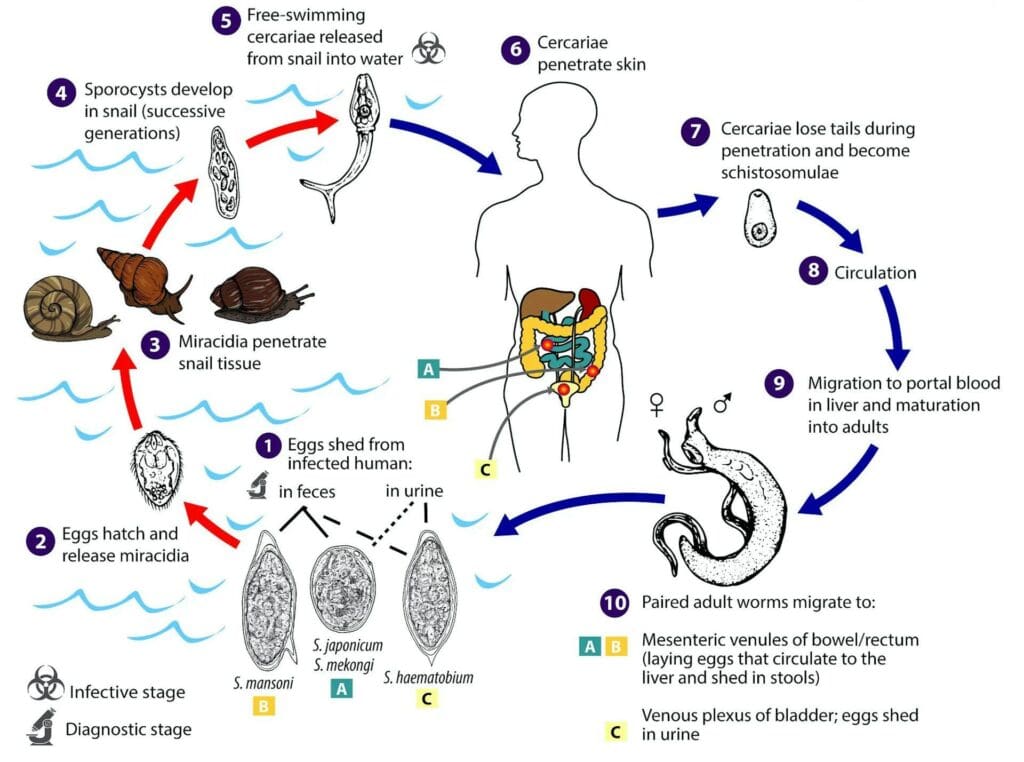Blood samples of patients infected with a parasitic worm that causes schistosomiasis contain hidden information that marks different stages of the disease. In our recently published research, our team used machine learning to uncover that hidden information and improve early detection and diagnosis of infection.
The parasite that causes schistosomiasis completes its life cycle in two hosts – first in snails and then in mammals such as people, dogs and mice. Freshwater worm eggs enter human hosts through the skin and circulate throughout the body, damaging multiple organs, including the liver, intestine, bladder and urethra. When these larvae reach blood vessels connecting the intestines to the liver, they mature into adult worms. They then release eggs that are excreted when the infected person defecates, continuing the transmission cycle.
Since diagnosis currently relies on detecting eggs in feces, doctors usually miss the early stages of infection. By the time eggs are detected, patients have already reached an advanced stage of the disease. Because diagnosis rates are poor, public health officials typically mass-administer the drug praziquantel to populations in affected regions. However, praziquantel cannot clear juvenile worms in early stages of infection, nor can it prevent reinfection.
Our study provides a clear path forward to improving early detection and diagnosis by identifying the hidden information in blood that signals active, early stage infection.
Your body responds to a schistosomiasis infection by mounting an immune response involving several types of immune cells, as well as antibodies specifically targeting molecules secreted by or present on the worm and eggs. Our study introduces two ways to screen for certain characteristics of antibodies that signal early infection.
The first is an assay that captures a quantitative and qualitative profile of immune response, including various classes of antibodies and characteristics that dictate how they communicate with other immune cells. This allowed us to identify specific facets of the immune response that distinguish uninfected patients from patients with early and late-stage disease.
Second, we developed a new machine learning approach that analyzes antibodies to identify latent characteristics of the immune response linked to disease stage and severity. We trained the model on immune profile data from infected and uninfected patients and tested the model on data that wasn’t used for training and data from a different geographical location. We identified not only biomarkers for the disease but also the potential mechanism that underlies infection.
Schistosomiasis is a neglected tropical disease that affects over 200 million people worldwide, causing 280,000 deaths annually. Early diagnosis can improve treatment effectiveness and prevent severe disease.
In addition, unlike many machine learning methods that are black boxes, our approach is also interpretable. This means it can provide insights into why and how the disease develops beyond simply identifying markers of disease, guiding future strategies for early diagnosis and treatment.
The schistosomiasis infection signatures we identified remain stable across two geographical regions across two continents. Future research could explore how well these biomarkers apply to additional populations.
Further, our work identifies a potential mechanism behind disease progression. We found that a particular immune response against a specific protein on the surface of the worm signals an intermediate stage of infection. Understanding how the immune system responds to this understudied antigen could improve diagnosis and treatment.
Besides improving our understanding of how the immune system responds to different stages of infection, our findings identify key antigens that could pave the way for designing cost-effective and efficient approaches to diagnosis and treatments. Our next steps will include actually deploying these strategies in the field for early detection and management of disease.
The Research Brief is a short take about interesting academic work.
This article is republished from The Conversation, a nonprofit, independent news organization bringing you facts and trustworthy analysis to help you make sense of our complex world. It was written by: Trirupa Chakraborty, University of Pittsburgh; Aniruddh Sarkar, Georgia Institute of Technology, and Jishnu Das, University of Pittsburgh
Read more: Viruses are doing mysterious things everywhere – AI can help researchers understand what they’re up to in the oceans and in your gut Identifying aquatic plants with drones could be the key to reducing a parasitic infection in people Ivermectin is a Nobel Prize-winning wonder drug – but not for COVID-19
Trirupa Chakraborty is affiliated with Light Up non-profit organisation, based in India. The organisation does not have any connection with or benefits from this article.
Aniruddh Sarkar has received grant funding from the NIAID, BARDA, Task Force for Global Health (TFGH), Atlanta Center for Point-of-Care Technologies (ACME POCT), Center for Childhood Infections & Vaccines (CCIV) and the Bernie Marcus Early Career Professorship at Georgia Tech
Jishnu Das has research grant funding from the NIH (NIAID, NHGRI, NIAMS, NEI, NCI, NHLBI, NIMH), DoD and the Rainin Foundation. He consults for Seromyx on a case-by-case basis and receives corresponding financial compensation including stock options. Seromyx has no direct connection to (including benefitting from financially or otherwise) this article.
